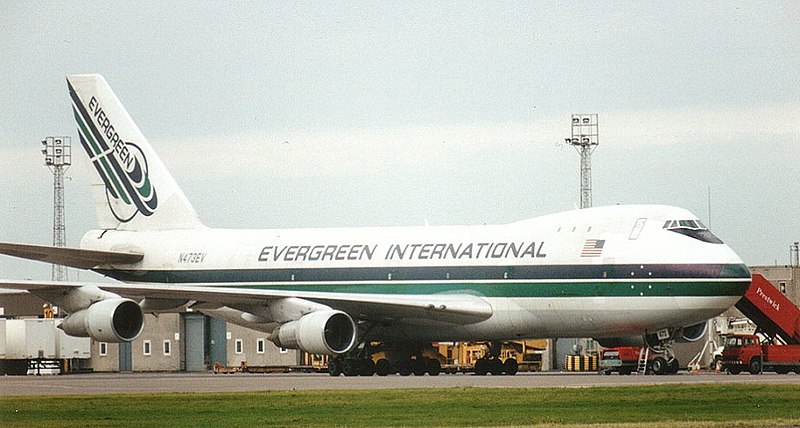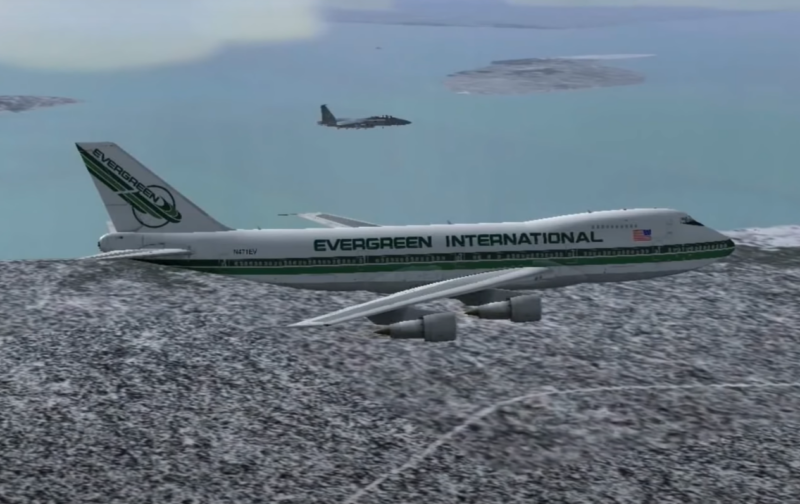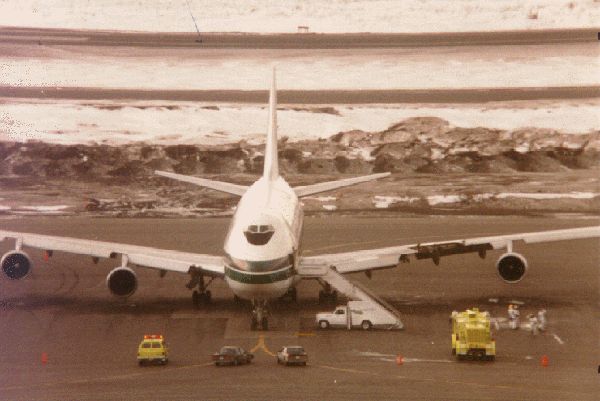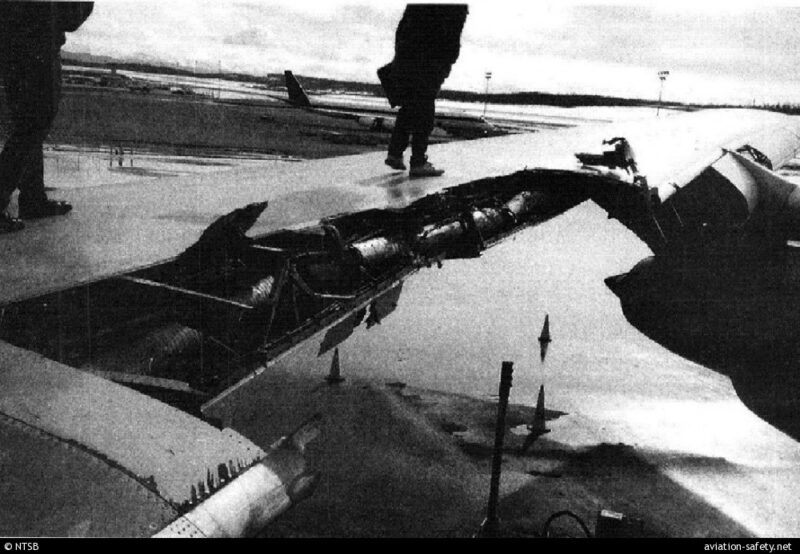On March 31, 1993, a Boeing 747 operating Japan Airlines Flight 46E from Anchorage to Chicago lost one of its engines shortly after takeoff. As a result, the bank angle exceeded 48 degrees, alternating with the wings level. Despite all the hurdles, the pilots managed to land the aircraft safely.
The Flight
The Boeing 747-121, with registration N473EV, was operating a cargo flight from Tokyo Narita to Chicago O’Hare International Airport with a fueling stop in Anchorage. Flight 46E was being operated by Evergreen International Airlines, on behalf of Japan Airlines. Three crew members and two nonrevenue passengers were on board the aircraft.
Once a passenger plane operated by Pan Am and TWA, the 747 was later converted into a freighter and joined the fleet of Evergreen International Airlines. Powered by four Pratt & Whitney JT9D-7D turbofan engines, it was a workhorse of the skies.

Flight 46E was under the command of a 42-year-old Captain who had logged more than 10,000 flight hours, including 750 hours on type. He was accompanied by a 47-year-old First Officer who had logged 10,500 flight hours, including 600 hours on the Boeing 747. Also, onboard was a 33-year-old Flight Engineer who had been with Evergreen since 1989 and had 2,600 flight hours.
The Ill-Fated Departure: Encounter with Turbulence
As the aircraft was preparing for takeoff, a forecast was provided for severe turbulence. The forecast indicated that severe turbulence had been reported by aircraft flying below 12,000 feet within a 60-nautical-mile radius.
While the aircraft taxied out of the ramp area around, the No. 2 engine start valve “open” light illuminated. Responding to this signal, the flight engineer took precautionary action by shutting down the No. 2 engine. The plane returned to the ramp for a maintenance inspection. Although the start valve was replaced, the persistent illumination of the light indicated an issue with the indicator system.
In compliance with the airlines’ FAA-approved Minimum Equipment List (MEL), the discrepancy was documented, and repair was deferred to a later date.
Amidst these repairs, a forecast was broadcasted over the ground control frequency. This forecast warned of moderate to frequent severe turbulence from the surface up to 12,000 feet, along with moderate to frequent severe mountain wave turbulence from 12,000 feet to 39,000 feet. This turbulent area extended from the surface to an altitude of 39,000 feet, with its northern boundary situated 36 miles south of Anchorage.

Following the inspection and repair, Flight 46E was cleared to taxi. As the Boeing 747 taxied onto the runway to await its takeoff clearance, the local controller informed the flight crew that, “Pilot reports severe turbulence leaving 2,500 (feet) climbing on the KNIK2 off runway 6R by the company (JAL/Evergreen flight 42E) B747.”
Note that 2KNIK is a standard instrument departure route used after takeoff from runway 6R at Anchorage. The Flight Engineer briefed the nonrevenue passengers concerning this reported turbulence.
Departure and Separation of Engine
At about 12:24 local time, flight 46E departed Anchorage. The aircraft’s computed takeoff weight of 733,778 pounds, slightly below its maximum takeoff weight of 740,000 pounds, dictated the need for runway 6R and maximum engine thrust. The Captain was the pilot flying (PF).
Shortly after takeoff, while the aircraft was climbing at about 2,000 feet, the flight crew initiated a left 20° bank turn to a heading of 330°. However, the aircraft experienced an uncommanded left bank further increasing the bank angle to approximately 50°.
At the same time, the aircraft experienced severe yaw and fluctuating airspeed. The No. 2 engine’s throttle slammed to its aft stop, its thrust reverser deployed unintentionally, and its electrical systems failed. Witnesses on the ground also reported witnessing dramatic pitch and roll oscillations before the engine separated.

Two U.S. Air Force F-15s were also flying in the area at the same time. The pilots of the F-15s noticed something large fall from the B747 as it departed from Anchorage. The radios in the F-15s did not have the proper frequencies to communicate directly with either Flight 46E or the ANC tower. Therefore, the pilots reported the event to the Elmendorf Air Force Base (AFB) tower.
On inspection, the pilots of the F-15s found that the B747 had lost the No. 2 engine, all of the leading edge devices between the No. 1 and No. 2 engines, and that the trailing edge flaps were damaged.
The AFB tower controllers released the information to the ANC tower controllers at 12:34 local time and advised them that something had fallen off a B747 that had just departed ANC.
Returning to Anchorage
Recognizing the severity of the situation, the flight crew declared an emergency. The Captain initiated a sharp left turn, aiming to return to Anchorage’s runway 6R. With the No. 2 engine lost and the remaining engine pushed to its limits, the aircraft’s bank angles reached as high as 40 degrees, alternating with level wings. According to the Captain, manual steering was used, and full right rudder application was occasionally necessary to maintain control.
As Flight 46E approached Fire Island during its final approach, the Captain instructed to halt fuel dumping. The landing gear was extended during this phase, and the aircraft aligned with the glideslope at an altitude of 500 to 600 feet. At 300 feet, the flaps were set to 25 degrees, and at around 12:45, Flight 46E notified the tower of their touchdown on the runway. The landing weight was approximately 685,000 pounds, exceeding the normal maximum certified landing weight of 585,000 pounds.

After landing, the Captain taxied the aircraft to the ramp area, reporting very hot left-side brakes to the ground personnel. Precautions were taken to prevent potential wheel and brake explosions due to the elevated temperatures.
Investigation and Findings: Unraveling the Mystery
The National Transportation Safety Board (NTSB) took charge of the investigation of Flight 46E, meticulously examining the wreckage, flight data, and witness accounts.
The investigation concluded that the probable cause of the accident was the lateral separation of the No. 2 engine pylon due to an encounter with severe turbulence and possibly extreme mountain waves and mechanical turbulence on departing Anchorage. This turbulence led to dynamic multi-axis lateral loadings that exceeded the pylon’s ultimate load-carrying capability, further exacerbated by a pre-existing fatigue crack.

- The turbulence encounter induced high lateral loads in the No. 2 engine pylon structure.
- The engine separated from the aircraft as a result of the structural breakup of the No. 2 engine pylon. The breakup began at a 2-inch-long fatigue crack in the forward firewall web, near the front engine mount bulkhead.
- The fatigue crack in the forward firewall web reduced the ultimate lateral load-carrying capability of the pylon structure by about 10 percent.
Aftermath
In the wake of this incident, several recommendations were made to the Federal Aviation Administration (FAA). These included the inspection of engine pylons, improved meteorological hazard assessments, enhancement of pylon structures’ lateral load capability, and alterations to departure routes during turbulent conditions.

Prior to Flight 46E’s takeoff, another Evergreen B747, operating Flight 42E on behalf of Japan Airlines, also experienced minor damage due to the turbulence. In response to the incident, the NTSB recommended that the FAA consider modifying the departure routes at Anchorage.
In addition, the event prompted a deeper understanding of aircraft structural dynamics and their vulnerability to extreme weather conditions.
The Boeing 747-121, N473EV, was repaired and returned to service before it was eventually retired and scrapped in 2001.



